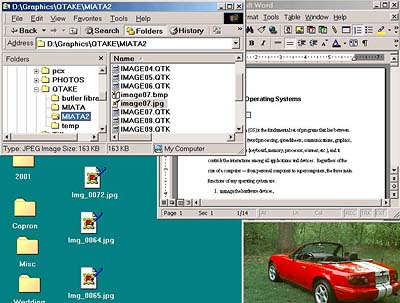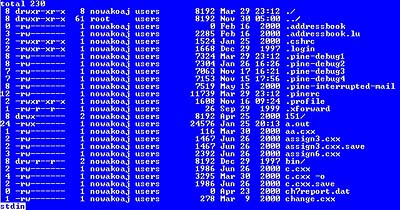
An operating system (OS) is the fundamental set of programs that lie between applications software (word processing, spreadsheets, communications, and graphics) and the hardware (keyboard, memory, processor, scanner, etc.).It controls the interactions among all applications and devices. Regardless of the size of a computer -- from personal computers to supercomputers, the three main functions of any operating system are:

However when using an Apple computer, one would type the command as CAT but not cat, which is short for catalog.
The first graphical user interface (GUI) was created in 1981, but it was not until 1984 when Apple introduced its Mac OS, that consumers could use this greatly improved interface. Shown here is a screen of a computer using the new Mac OS X software.

Since that time all the major personal computer operating systems have a GUI, and shown here is a screen of a computer using the new Microsoft Windows Me software.

The Microsoft's family of Windows 3.x products were not true operating systems, but Microsoft's current home use products, Windows 9x and ME and their business use products, Windows NT.x and Windows 2000 are true operating systems. Microsoft also markets a scaled down memory-resident version of its operating system called Windows CE (Consumer Electronics) for palmtop computers and other portable electronic devices.

A newer PC operating system is Linux. Named for its creator Linus Torvalds, Linux is based on the Unix mainframe operating system. The major attractions of Linux are its multiuser and Internet server capabilities. Although there are a variety of GUI's supplied with it, may users prefer to use the cryptic Unix-like text-based/command-driven user interface. Shown below is the result of typing the ls -l command to display file information. In addition to displaying the common file information, this command also indicates the types of permission -- read, write, and execute access -- that are given on the owner, group (selected users), and world (everybody) levels. For example the permissions on the file named a.out are read, write, and execute for the owner, but no permissions are given for group or world. However for the directory named bin (indicated by the leading letter "d"), the owner has read and write access while both the group and world have read access to it.
